In-Depth
Dynamics CRM 2011 Review: Strong Play by Microsoft
Putting the latest version of the Microsoft CRM tool through its paces, we found many worthwhile improvements among the 500 or so new features that give Microsoft partners an even more solid competitor to Salesforce.com and Oracle.
There's no doubt that a customer relationship management (CRM) system can make a company more efficient at retaining existing customers and gaining new business. It's also a fact that many CRM implementations fail to meet their goals because of poor user adoption. A good CRM system must be customized to the way the business and people work, and must not try to force people to adjust to the system. The CRM battle has heated up with the release of the latest Microsoft offering in January -- a cloud solution in the form of Microsoft Dynamics CRM Online -- which was followed in February by the on-premises solution.
One major competitor to Microsoft is Salesforce.com Inc. Microsoft is playing heavily on the fact that Dynamics CRM 2011 Online can be accessed in the cloud, either from Microsoft or from third-party hosting partners, as well as be installed on-premises, whereas Salesforce.com is online-only. Dynamics CRM Online is priced at $34 per seat per month (for the first year), which also adds to the appeal because it's a lot less than Salesforce.com's $125 per month Enterprise service.
Customer-Centric Service
A few years ago, CRM was regarded by many businesses as "nice to have," but now it's a necessity. Smart businesses are making sure that more staff have access beyond just the marketing and sales departments. Having one central repository for all staff with all of the information about your company's interaction with everyone else is a powerful productivity booster.
CRM used to be about sales, marketing and customer service, but the scope has widened considerably over the last few years. Now it's about xRM: relationships with more than just customers, such as contractors, suppliers, resellers and others.
The recovering economy also makes excellent customer service important. Furthermore, consumers are more discerning and have unparalleled access to vendor information, as well as social networks to give them instant feedback on particular brands or products.
Installation
If you opt to run Dynamics CRM 2011 on-premises, it runs only on Windows Server 2008/2008 R2 x64 (Standard, Enterprise and Datacenter, as well as Small Business Server 2008), and requires SQL Server 2008 x64 SP1 (Standard, Enterprise and Datacenter) as the storage back-end. Dynamics CRM can run in a virtual server on Hyper-V or any other hypervisor on the Microsoft Windows Server Virtualization Validation Program (SVVP). A quad-core, 2GHz-plus CPU is recommended, as is 8GB of RAM; minimum requirements are 2GB of memory and an x64 1.5GHz or faster CPU.
There are two on-premises flavors: Dynamics CRM 2011 Server, which has no user limits, allows multiple organizations and lets you spread the server roles across several machines; and Dynamics CRM Workgroup Server 2011, which can only be installed on one server with a single organization and is capped at five users.
Dynamics CRM 2011 is available in 41 languages, and global organizations can show the UI in the local language while still having a single, central database. The Web client that's used for both cloud and on-premises requires either Internet Explorer 7, 8 or 9, running on Windows XP or later.
A Fresh Outlook
While Dynamics CRM 4.0 has an Outlook-integrated client, Dynamics CRM 2011 takes this to the next level with a single installer for both the online and on-premises client, as well as supporting both 32-bit and 64-bit versions of Office. The client is updated through Microsoft Update and can connect to multiple Dynamics CRM organizations; the most noticeable improvement is the polished integration with Outlook. Many users might not even realize they're not using Outlook but are in fact interacting with Dynamics CRM, as it behaves just like Outlook. An extra tab shows up in the ribbon, and there are a few Dynamics CRM-specific buttons as well as a new section for your company (Figure 1).
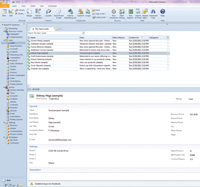
[Click on image for larger view.] |
| Figure 1. New tabs at the top, along with left-hand categories, make for less clicking overall. |
Contacts are easily imported and kept in sync. The new tracking pane makes it easy to keep tabs on e-mails and appointments with particular customers. The client also offers the ability to control which e-mails, appointments and tasks are pushed to Outlook through new personal filters. Outlook in Microsoft Office 2003 SP3, Office 2007 SP2 and Office 2010 is supported for Dynamics CRM 2011 on Windows XP or later.
If all users are using Outlook as their client for Dynamics CRM, there's no need for the optional e-mail router. The Dynamics CRM 2011 e-mail router helps with both online and on-premises scenarios and interfaces with Exchange or Exchange Online to provide tracking and routing of e-mails for users who use the Web client. New in the 2011 version is that the e-mail router supports Exchange 2010 and Exchange Online and also works with Autodiscover to let Outlook automatically find the right settings and configure itself.
Using Dynamics CRM 2011
For users of Dynamics CRM 4.0, the most noticeable difference will be the new Office ribbon-inspired UI in both Outlook and the Web client that's contextual and adapts to the task at hand.
Quality of data is crucial in a CRM system, and a frequent problem when staff are adding information is the creation of duplicate records. When you enable it, Dynamics CRM 2011 can automatically detect duplicates when importing from a file, when creating a new contact or when Outlook goes online after having been offline. Filtering views will be familiar to users of the equivalent feature in Excel. Another example of Office integration is the ability to export lists to Excel, make changes and then easily import the data again. Dynamics CRM 4.0 only allowed export to Excel.
Inline data visualizations make it easy to understand data and trends, whereas user-configured conditional formatting lets you highlight important information. Dashboards have been improved, and it's now easy for a user to set up their own view of all the important information they need (Figure 2). Dashboards are also dynamic, so you can click through charts to drill down to the underlying data. Goal management has been improved and can now be set on any characteristic, not just sales volume for salespeople, but cases closed for customer service personnel, for instance.
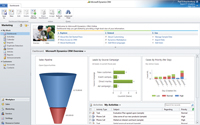
[Click on image for larger view.] |
| Figure 2. Easily customize your own view into CRM with quick access to the data that matters most to you. |
At the heart of any xRM system is the concept of managing relationships. Dynamics CRM 2011 improves this considerably by introducing a new section devoted to connections, where users can define relationships between contacts and accounts easier than in earlier versions of CRM. Competitors can also be tracked, including entering a Strengths, Weaknesses, Opportunities and Threats (SWOT) analysis of them.
Other little details that will make a difference to end users' productivity are record pinning (which saves particular accounts as favorites) and an overall reduction in clicks required to navigate the UI. There's also a list of most recently used areas that makes it easy to go back to an account you've just worked on (Figure 3). Recurring appointments is a new feature and will work well for service organizations that provide scheduled services. Multiple products and services can be bundled together and sold as product kits, with corresponding discounts.
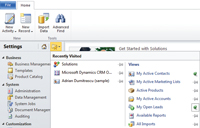
[Click on image for larger view.] |
| Figure 3. Quickly see which areas in CRM you've been to, and pin records for easy access. |
Next Page: Follow the Custom
Follow the Custom
Even the simplest CRM implementation requires some customization, and fortunately this has been made easier in Dynamics CRM 2011. Forms now have customizable headers and footers that stay put even when content in between is scrolled, and drag-and-drop is fully supported when designing forms. Another powerful addition is sub-grids, which can show lists of records in one form, where Dynamics CRM 4.0 had to open separate pages for each record.
Dynamics CRM 4.0 had a fixed list of activities, whereas now organizations can define their own activities -- for instance, creating "onsite repair," which can then be tracked. In Dynamics CRM 4.0, each activity had to be opened individually to change the status; this can be done in bulk in the new release. When you want to collect a fair bit of information from a user or provide a guided approach for problem solving, Dynamics CRM 2011 now offers a guided dialog feature that presents a set of screens (a wizard) for the user to input data. These process-oriented dialogs can also incorporate the powerful workflow features of Dynamics CRM 2011.
Auditing of actions in CRM 2011 is now built-in, as is field-level security. Another powerful addition is role-tailored views, which can hide or show certain fields in a form, depending on who's viewing the information. This can be used not only as a security feature, but also to make sure users focus on the information their job role demands. A user can have one or more roles assigned to them, and roles can be scoped to geographical locations (Figure 4).
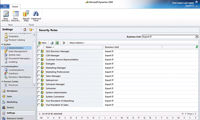
[Click on image for larger view.] |
| Figure 4. Use one of the included security roles, or customize to create your own roles. |
There are new mobile-friendly forms, and the fact that scripts and Web resources can be stored in reusable libraries instead of having to be copied to each individual form should prove very popular with developers.
For more advanced customization, it pays to know that Dynamics CRM 2011 is written in the Microsoft .NET Framework 4, enabling the use of C# assemblies; it also lets you call third-party Web services. Developers can also incorporate Silverlight, Windows Communication Foundation and Language Integrated Query (LINQ) while developing cloud-capable solutions.
Another big boon for ISVs is the ability to package an add-on into a solution. This wraps up custom code, scripts, HTML pages and other elements into a single package and also allows the author to control what parts can and can't be changed with versioning support (Figure 5). Dynamics CRM 2011 is also Windows Azure-aware, which opens up the possibility for developers to create highly scalable solutions easily. The fact that the Visual Studio Workflow designer can be used to build workflows directly for Dynamics CRM will also make developers' jobs lighter.
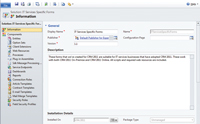
[Click on image for larger view.] |
| Figure 5. Wrap up and export your hard customization work in a few easy steps. |
Social Networks and CRM
There's no doubt that the likes of Facebook, LinkedIn and Twitter are changing the way businesses look at marketing. In this increasingly interconnected world, it's vital that a company is aware of what's said about it and its products. Gathering information about potential customers and competitors is also key.
There's a Social Networking Accelerator for Dynamics CRM 4.0, and an updated version is coming for Dynamics CRM 2011. Unfortunately, there's no date as of yet. For users who access Dynamics CRM through Outlook, many social networking benefits can be had today through the excellent Outlook Social Connector for Outlook 2003/2007/2010.
Share and Share Alike
SharePoint is the premier Microsoft file and collaboration tool; in Dynamics CRM 4.0, it required custom coding to integrate it. In what is possibly the most important new feature of Dynamics CRM 2011, integrating the two is now a very simple process (Figure 6). Note that it's possible to integrate an on-premises Dynamics CRM with a hosted SharePoint environment (Office 365), or Dynamics CRM Online with SharePoint on-premises (provided it can be accessed from the Internet) -- and even Dynamics CRM Online with SharePoint Online. If you don't use SharePoint, the traditional method of file attachments is still available in Dynamics CRM 2011.
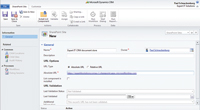
[Click on image for larger view.] |
| Figure 6. Integrating SharePoint and Dynamics CRM is now just a few clicks and a simple installation away. |
If you're using Business Connectivity Services in SharePoint (BCS, called Business Data Catalog in SharePoint 2007), it can be connected to Dynamics CRM 2011. For those businesses that have opted for Microsoft Lync for their communication needs, Dynamics CRM 2011 integrates well with it and provides presence and communication tools directly in the UI.
The Best of Both Worlds?
If you're looking to implement Dynamics CRM 2011 on-premises, there's a fair bit of planning involved, depending on the size of the business. Microsoft has a good planning document available that outlines each step, and also provides additional documents and checklists. The on-premises path will suit organizations that have deep customization needs or who want to integrate Dynamics CRM with other business applications. Some businesses have requirements that stipulate that the data has to stay in-house, but many businesses in today's economy will have more operational budget than capital expense budget. Going with Dynamics CRM Online also makes it easy to get started quickly. Another powerful feature is that moving from one to the other really just involves copying configuration and data. Many companies find their feet with a pilot in Dynamics CRM Online before proceeding with a full-scale, on-premises implementation.
Microsoft is currently offering a promotion (until June 30, 2011) where an organization will receive $200 per user for switching from a competitor's product to Dynamics CRM 2011 Online. The minimum purchase is 15 licenses, and you have to sign up for a two-year licensing subscription. The maximum number of licenses that can receive the payment is 250. Competing products have to be from either Salesforce.com (Pro, Enterprise or Unlimited Edition) or Oracle Corp. (Siebel CRM or CRM On-Demand).
Extend Dynamics CRM 2011
At the same time as releasing Dynamics CRM 2011, Microsoft also opened up the Microsoft Dynamics Marketplace so that ISVs can easily reach potential customers with their extensions. Even though it's early days for the Marketplace, there's a good selection of add-ons for Dynamics CRM 2011. Here are some of the more interesting packages; all of these work with CRM 2011 on-premises, and all but Vibe and InsideView for Sales work with Dynamics CRM Online:
- Vibe from Sonoma Partners LLC is free and is like Facebook for Dynamics CRM 2011. It gives employees, especially geographically dispersed ones, the ability to "chat" with other staff members and follow what they're doing.
- Dynamics CRM Online Quick Start Template by Zero2Ten Inc. provides templates to help you get up and running much quicker than you can with vanilla Dynamics CRM, and give you a leg-up in adapting Dynamics CRM to work the way your business works.
- Customer Portal by Microsoft Dynamics Labs is a free add-on from Microsoft that gives you a portal for your customers and allows them to interact with Dynamics CRM (examples include lead generation, service scheduling, case management, event calendar, product registration, self-help knowledge base and content management).
- MobileAccess 5.0 by TenDigits Software Inc. lets your people access Dynamics CRM while on the road, whether from BlackBerry devices, iPhones or iPads. The concept of "one product for all smartphones" is popular, as is the power of the tool.
- InsideView for Sales by InsideView Inc. integrates company information from LinkedIn, Facebook and more than 20,000 Web sites and blogs, as well as Twitter, to give sales a good insight into all sources of information.
- Scribe Replication Services by Scribe Software Corp. provides reassurance if you're worried about all your CRM data living in the cloud, or have regulatory requirements to have data on-site as well as in the cloud. Replication seamlessly keeps the data in the cloud in sync with a SQL Server on-site.
Strong Play by Microsoft
Dynamics CRM 2011 has more than 500 improvements, integrates seamlessly with Outlook and Office and provides an outstanding CRM environment. Whether this new version, its price and the accompanying promotions are enough to give Salesforce.com a run for its money remains to be seen.
One important thing for Dynamics CRM partners to realize is that their role will change. A business can now set up a trial of Dynamics CRM 2011 Online in a matter of minutes, without involving a partner. On the other hand, this is likely to put Dynamics CRM in the minds of many businesses that might not otherwise have considered it, and the key to any successful CRM implementation is customization -- something most businesses will need partner assistance with.